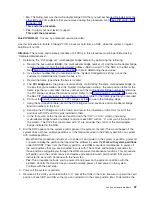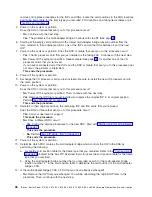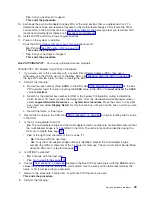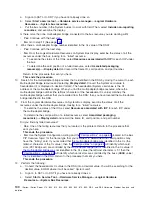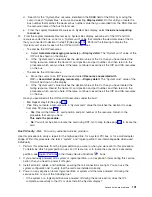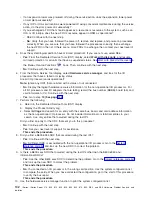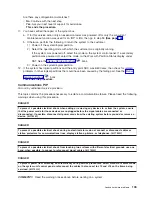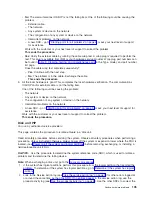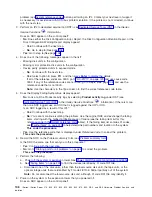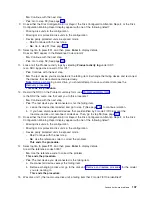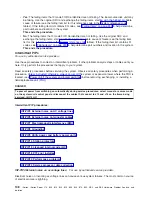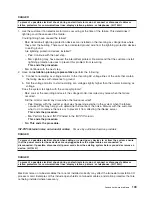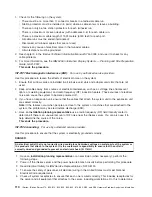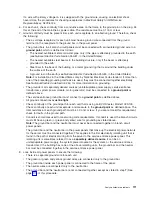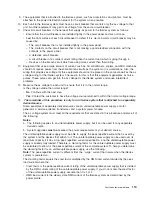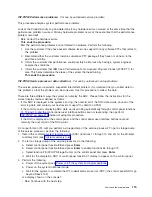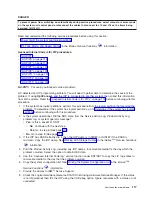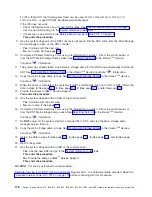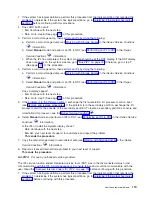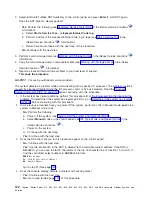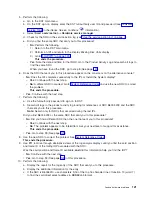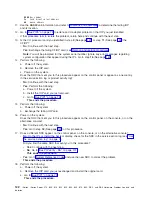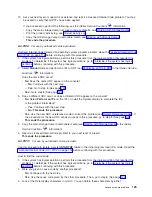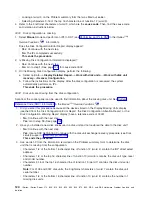
if
a
wire
with
primary
voltage
on
it
is
swapped
with
the
ground
wire,
causing
an
electrical
shock
hazard.
Use
the
procedures
for
checking
receptacles
in
Electrical
Safety
for
IBM
Service
Representatives
,
S229-8124.
6.
For
each
unit,
check
continuity
from
a
conductive
area
on
the
frame
to
the
ground
pin
on
the
plug.
Do
this
at
the
end
of
the
mainline
ac
power
cable.
The
resistance
must
be
0.1
ohm
or
less.
7.
Ground
continuity
must
be
present
from
each
unit
receptacle
to
an
effective
ground.
Therefore,
check
the
following:
v
The
ac
voltage
receptacle
for
each
unit
must
have
a
ground
wire
connected
from
the
ground
terminal
on
the
receptacle
to
the
ground
bar
in
the
power
panel.
v
The
ground
bars
in
all
branch
circuit
panels
must
be
connected
with
an
insulated
ground
wire
to
a
ground
point
,
which
is
defined
as
follows:
–
The
nearest
available
metal
cold
water
pipe,
only
if
the
pipe
is
effectively
grounded
to
the
earth
(see
National
Electric
Code
Section
250-81,
in
the
United
States).
–
The
nearest
available
steel
beams
in
the
building
structure,
only
if
the
beam
is
effectively
grounded
to
the
earth.
–
Steel
bars
in
the
base
of
the
building
or
a
metal
ground
ring
that
is
around
the
building
under
the
surface
of
the
earth.
–
A
ground
rod
in
the
earth
(see
National
Electric
Code
Section
250-83,
in
the
United
States).
Note:
For
installations
in
the
United
States
only,
by
National
Electrical
Code
standard,
if
more
than
one
of
the
preceding
grounding
methods
are
used,
they
must
be
connected
together
electrically.
See
National
Electric
Code
Section
250,
for
more
information
on
grounding.
v
The
grounds
of
all
separately
derived
sources
(uninterruptable
power
supply,
service
entrance
transformer,
system
power
module,
motor
generator)
must
be
connected
to
a
ground
point
as
defined
above.
v
The
service
entrance
ground
bar
must
connect
to
a
ground
point
as
defined
above.
v
All
ground
connections
must
be
tight
.
v
Check
continuity
of
the
ground
path
for
each
unit
that
is
using
an
ECOS
tester,
Model
1023-100.
Check
continuity
at
each
unit
receptacle,
and
measure
to
the
ground
point
as
defined
above.
The
total
resistance
of
each
ground
path
must
be
1.0
ohm
or
less.
If
you
cannot
meet
this
requirement,
check
for
faults
in
the
ground
path.
v
Conduit
is
sometimes
used
to
meet
wiring
code
requirements.
If
conduit
is
used,
the
branch
circuits
must
still
have
a
green
(or
green
and
yellow)
wire
for
grounding
as
stated
above.
Note:
The
ground
bar
and
the
neutral
bar
must
never
be
connected
together
in
branch
circuit
power
panels.
The
ground
bar
and
the
neutral
bar
in
the
power
panels
that
make
up
the
electrical
power
network
for
the
server
must
be
connected
together.
This
applies
to
the
first
electrically
isolating
unit
that
is
found
in
the
path
of
electrical
wiring
from
the
server
to
the
service
entrance
power
panel.
This
isolating
unit
is
sometimes
referred
to
as
a
separately
derived
source
.
It
can
be
an
uninterruptable
power
supply,
the
system
power
module
for
the
system,
or
the
service
entrance
transformer.
If
the
building
has
none
of
the
above
isolating
units,
the
ground
bar
and
the
neutral
bar
must
be
connected
together
in
the
service
entrance
power
panel.
8.
Look
inside
all
power
panels
to
ensure
the
following:
v
There
is
a
separate
ground
wire
for
each
unit.
v
The
green
(or
green
and
yellow)
ground
wires
are
connected
only
to
the
ground
bar.
v
The
ground
bar
inside
each
power
panel
is
connected
to
the
frame
of
the
panel.
v
The
neutral
wires
are
connected
only
to
the
neutral
bar.
v
The
ground
bar
and
the
neutral
bar
are
not
connected
together,
except
as
stated
in
step
7
(See
page
of
this
procedure.
Analyze
hardware
problems
111

